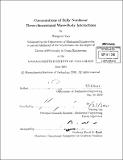| dc.contributor.advisor | Yuming Liu. | en_US |
| dc.contributor.author | Yan, Hongmei | en_US |
| dc.contributor.other | Massachusetts Institute of Technology. Dept. of Mechanical Engineering. | en_US |
| dc.date.accessioned | 2011-03-07T15:24:15Z | |
| dc.date.available | 2011-03-07T15:24:15Z | |
| dc.date.copyright | 2010 | en_US |
| dc.date.issued | 2010 | en_US |
| dc.identifier.uri | http://hdl.handle.net/1721.1/61616 | |
| dc.description | Thesis (Ph. D. in Ocean Engineering)--Massachusetts Institute of Technology, Dept. of Mechanical Engineering, 2010. | en_US |
| dc.description | Cataloged from PDF version of thesis. | en_US |
| dc.description | Includes bibliographical references. | en_US |
| dc.description.abstract | Nonlinear effects in hydrodynamics of wave-body interaction problems become critically important when large-amplitude body motions and/or extreme surface waves are involved. Accurate prediction and understanding of these fully nonlinear effects are still challenges in the design of surface ships and marine structures, owing to the complexity of the hydrodynamic problem itself and limited computational facilities. This research is focused on: (i) development of a highly efficient numerical scheme for the computation of fully-nonlinear three-dimensional wave-body interactions; and (ii) investigation of several highly nonlinear wave-body interaction problems for understanding associated key nonlinear effects. A highly efficient high-order boundary element method is developed based on the framework of the quadratic boundary element method (QBEM) for the boundary integral equation and using the pre-corrected fast Fourier transform (PFFT) algorithm to accelerate the evaluation of far-field influences of source and/or normal dipole distributions on boundary elements. The resulting numerical scheme reduces the computational effort of solving the boundary-value problem from O(N 2 ~3) (with the traditional boundary element methods) to O(N ln N) where N represents the total number of boundary unknowns. Combining with the mixed-Eulerian-Lagrangian (MEL) approach for nonlinear free surface tracking, we develop an efficient and accurate initial boundary value problem (IBVP) solver, PFFT-QBEM, which allows for practical simulations of fully nonlinear three-dimensional wave-body interaction problems. Three nonlinear wave-body interaction problems, which are of scientific interest and practical importance, are investigated in detail: water surface impact of threedimensional objects, cavity dynamics in water entries, and coupled unstable motions of floating structures in waves. For the water impact problem, with the development of an adaptive jet flow treatment and an effective approach for accurately tracking water-body separation point/line, we obtain a thorough understanding of the gravity effect on the characteristics of slamming pressure/load on the object and free-surface profiles. For the cavity problem, we investigate the formation and evolution of an air cavity behind an object dropped into water (from air) at relatively low Froude numbers where the inertia and gravity effects are comparable. A theoretical solution is newly derived based on a matched asymptotic approach and a fully nonlinear numerical simulation is carried out, for the description of the kinematics and dynamics of the air cavity. Satisfactory quantitative comparisons are obtained among the theoretical predictions, numerical simulations, and existing experimental measurements for the dependence of cavity shape and closure time/height on Froude number and body geometry. For floating structures in waves, our focus is on the understanding of the fundamental mechanism and basic characteristics for coupled unstable heave-pitch motions of floating platforms/vessels. Through stability analyses, we identify that the second-order difference-frequency interaction between surface waves and body motions is the key mechanism for the excitation of unstable resonant motions. Fully nonlinear simulations are conducted to study the development of large-amplitude body motions and investigate quantitatively the dependence of the instability on related physical parameters, such as incident wave amplitude and phase, frequency detuning, body geometry, and system damping. Theoretical analyses and numerical simulations are verified by comparison to available experiments for the coupled unstable motions of a deep draft caisson vessel (DDCV). | en_US |
| dc.description.statementofresponsibility | by Hongmei Yan. | en_US |
| dc.format.extent | 297 p. | en_US |
| dc.language.iso | eng | en_US |
| dc.publisher | Massachusetts Institute of Technology | en_US |
| dc.rights | M.I.T. theses are protected by
copyright. They may be viewed from this source for any purpose, but
reproduction or distribution in any format is prohibited without written
permission. See provided URL for inquiries about permission. | en_US |
| dc.rights.uri | http://dspace.mit.edu/handle/1721.1/7582 | en_US |
| dc.subject | Mechanical Engineering. | en_US |
| dc.title | Computations of fully nonlinear three-dimensional wave-body interactions | en_US |
| dc.type | Thesis | en_US |
| dc.description.degree | Ph.D.in Ocean Engineering | en_US |
| dc.contributor.department | Massachusetts Institute of Technology. Department of Mechanical Engineering | |
| dc.identifier.oclc | 704761084 | en_US |
